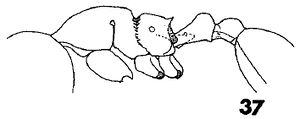Carebara borealis
| Carebara borealis | |
|---|---|

| |
| Scientific classification | |
| Kingdom: | Animalia |
| Phylum: | Arthropoda |
| Class: | Insecta |
| Order: | Hymenoptera |
| Family: | Formicidae |
| Subfamily: | Myrmicinae |
| Tribe: | Crematogastrini |
| Genus: | Carebara |
| Species: | C. borealis |
| Binomial name | |
| Carebara borealis (Terayama, 1996) | |
| Common Name | |
|---|---|
| Oo-kotsuno-ari | |
| Language: | Japanese |
This is a very rare species with only three collection records from Honshu, Japan (Japanese Ant Image Database).
Identification
Distribution
Distribution based on Regional Taxon Lists
Palaearctic Region: Japan (type locality).
Distribution based on AntMaps
Distribution based on AntWeb specimens
Check data from AntWeb
Countries Occupied
| Number of countries occupied by this species based on AntWiki Regional Taxon Lists. In general, fewer countries occupied indicates a narrower range, while more countries indicates a more widespread species. |

|
Estimated Abundance
| Relative abundance based on number of AntMaps records per species (this species within the purple bar). Fewer records (to the left) indicates a less abundant/encountered species while more records (to the right) indicates more abundant/encountered species. |

|
Biology
Castes
Worker
 
| |
| . | |
Nomenclature
The following information is derived from Barry Bolton's Online Catalogue of the Ants of the World.
- borealis. Oligomyrmex borealis Terayama, 1996: 19, figs. 34-37 (s.w.) JAPAN.
- Type-material: holotype major worker, 32 paratype minor workers.
- Type-locality: holotype Japan: Aomori Pref., Shimokita-gun, Higashi-dori-mura, 5.viii.1994 (K. Murata); paratypes with same data.
- Type-depositories: MNHA (holotype); NIAS, NSMT (paratypes).
- Combination in Carebara: new combination (unpublished).
- Status as species: Imai, et al. 2003: 130.
- Distribution: Japan.
Unless otherwise noted the text for the remainder of this section is reported from the publication that includes the original description.
Description
Worker
Holotype. Major. HL 0.98 mm; HW 0.95 mm; SL 0.45 mm; CI 97; SI 4 7; WL 1.13 mm; PW 0.60 mm; PL 0.45 mm; PH 0.28 mm; DPW 0.23 mm; TL 3.4 mm.
Head almost as long as wide, with concave posterior margin in frontal view; vertex with a pair of strong tubercles; lateral margins gradually converging below in frontal view. Mandibles with 6 strong teeth. Antennae with 9 segments; scape short, 0.4 x head length; 2nd segment 2.5 x as long as wide; 3rd to 6th segments each wider than long; 7th segment longer than wide; 8th segment 1.5 x as long as wide; apical segment 2.0 x as long as wide. Eyes larger than the maximum width of antennal scape, each consisting of 5 facets, and situated almost midlength of head capsule in lateral view. A small anterior ocellus present.
Alitrunk massive; promesonotum strongly convex in lateral view; scutellum present; mesopleura with a distinct transverse groove medially; metanotum distinct; acute propodeal spines present; posterior margins of propodeum carinate, forming a thin lamellar wall.
Petiole longer than high, with broadly convex dorsal margin in lateral view; subpetiolar process small, forming an obtuse triangle. Postpetiole slightly higher than long, with convex dorsal margin and concave ventral margin in lateral view.
Head microreticulate with numerous longitudinal striae. Alitrunk covered with small punctures coarsely, excepting pronotum, rnesonotal dorsum and upper 2/3 of mesopleura smooth and shining in most part. Petiole microreticulate; postpetiole with weakly microreticulate lateral faces and very weakly microreticulate and much shining dorsal face. Gaster smooth and shining.
Ground color reddish brown and head much darker.
Paratype minor workers. HL 0.48-0.50 mm; HW 0.45-0.47 mm; SL0.28-0.29 mm; CI 94-95; SI 61-62; WL 0.58-0.60 mm; PW 0.28-0.30 mm; PL 0.22-0.23 mm; PH 0.15 mm; DPW 0.11 mm; TL 1.4-1.5 mm (n = 5).
Head almost as long as wide, with subparallel sides and weakly concave posterior margin in frontal view. Mandibles with 5 teeth. Antennae with 9 segments; scape 0.5 x head length; 2nd segment longer than wide; 3rd to 7th segments each wider than long; 8th segment longer than wide; apical segment 2.0x as long as wide. Eyes small, consisting of a single facet only, and situated almost midlength on head capsule in lateral view.
Prornesonotal dorsum broadly convex in lateral view; rnetanotal groove deeply incised dorsally; propodeal dorsum straight; posterior margins of propodeum carinate, forming a thin lamella; acute propodeal spines present.
Petiole longer than high, with broadly convex dorsal margin in lateral view; subpetiolar process minute, forming an obtuse triangle. Postpetiole 1.2x as long as wide, with broadly convex dorsal margin and concave ventral margin in lateral view.
Head and pronotum smooth and shining; mesonotum, mesopleura and propodeum microreticulate; petiole microreticulate; postpetiole weakly microreticulate; gaster impunctate and shining.
Body yellowish brown; gaster and legs lighter.
Type Material
Holotype. Major worker, Higashi-dori-mura, Shimokitagun, Aomori Pref., 5.VIII.1994, K. Murata leg. Paratypes. 32 minor workers, same data as holotype.
References
- Hisasue, Y. 2019. Ants collected from Akita Prefecture (Japan) in August 2017. ARI 40: 15-18.
- Terayama, M. 1996b. Taxonomic studies on the Japanese Formicidae, part 2. Seven genera of Ponerinae, Cerapachyinae and Myrmicinae. Nature and Human Activities. 1:9-32. (page 19, figs. 34-37 soldier, worker described)
References based on Global Ant Biodiversity Informatics
- Terayama M. 1996. Taxonomic studies on the Japanese Formicidae, part 2. Seven genera of Ponerinae, Cerapachyinae and Myrmicinae. Nature & Human Activities 1: 9-32.
- Terayama M., S. Kubota, and K. Eguchi. 2014. Encyclopedia of Japanese ants. Asakura Shoten: Tokyo, 278 pp.
